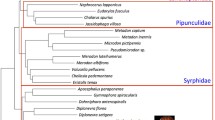Abstract
This is the first discovery of nesting an ant queen in the mantid’s oothecae chamber. A total of 93 oothecae have been collected and dissected. After tearing the outer skin of the most oothecae apart (80 out of 93), a queen ant Crematogaster inermis (Formicidae: Crematogastrini) and her eggs were observed. All of these 80 oothecae were parasited by parasitoid wasp Podagrion pachymerum (Chalcidoidea: Toryminae). According to our observations, it was assumed that the ant, Crematogaster inermis (Formicidae: Crematogastrini), inhabited the oothecae of mantid, Hierodula tenuidentata (Mantidae: Paramantini), to get a ready nest and accessible food using parasitoid wasps. We observed a mixed-species aggregation of arthropods in most of the examined oothecae. The arthropods that were observed in most of the collected oothecae are listed below: An ant, Crematogaster inermis (Formicidae: Crematogastrini); a mimicking spider ant, Synageles persianus (Salticidae: Dendryphantini); a parasitoid, Podagrion pachymerum (Chalcidoidea: Toryminae); a pseudoscorpion species, Chernes sp. (Chernetidae: Chernetini); a thysanoptera species, Haplothrips sp. (Phlaeothripidae: Haplothripini) and a neuroptera species, Semidalis sp. (Coniopterygidae: Conwentziini).



Similar content being viewed by others
References
Agrawal AA, Ackerly DD, Adler F, Arnold AE, Cáceres C et al (2007) Filling key gaps in population and community ecology. Front Ecol Environ 5:145–152
Bach CE (1991) Direct and indirect interactions between ants (Pheidole megacephala), scales (Coccus viridis) and plants (Pluchea indica). Oecologia 87:233–239
Birkhofer K, Bylund H, Dalin P, Ferlian O, Gagic V et al (2017) Methods to identify the prey of invertebrate predators in terrestrial field studies. Ecol Evol 7:1942–1953
Blum MS (1981) Chemical defense of arthropods. Academic Press, New York
Breland OP (1941) Podagrion mantis Ashmead and other parasites of praying mantid egg cases (Hym, Chalcidoidea; Dipt, Chloropidae). Ann Entomol Soc Am 34(1):99–113
Brunet PCJ (1951) The Formation of the Ootheca by Periplaneta americana: I. The Micro-anatomy and Histology of the posterior part of the Abdomen. J Cell Sci 18:3–92
Chomicki G, Renner SS (2017) The interactions of ants with their biotic environment. Proc R Soc B Biol Sci. https://doi.org/10.1098/rspb.2017.0013
Clausing G (1998) Observations on ant- plant interactions in Pachycentria and other genera of the Dissochaeteae (Melastomataceae) in Sabah and Sarawak. Flora Jena 193:361–368
Compton SG, Robertson HG (1988) Complex interactions between mutualisms: ants tending homopterans protect fig seeds and pollinators. Ecology 69:1302–1305
Coombs M (1994) Seasonality and host relationships of insects associated with oothecae of Archimantis latistyla (Serville) (Mantodea, Mantidae). Austral Entomol 33(3):295–298
Curtis J (1834) British Entomology: being Illustrations and Descriptions of the Genera of Insects found in Great Britain and Ireland: containing Coloured Figures from Nature of the Most Rare and Beautiful Species, and in Many Instances of the Plants upon which they are found. Vol. 4. Ellis, London.
Dejean A, Bourgoin T, Gibrenau M (1997) ant species that protect figs against other ants: result of territoriality induced by a mutualistic homopteran. Ecoscience 4:446–453
Edmunds M (1976) The defensive behavior of Ghanaian praying mantids with a discussion of territoriality. Zool J Linnean Soc. https://doi.org/10.1111/j.1096-3642.1976.tb00818.x
Eisner T (1970) Chemical defense against predation in arthropods. In: Sondheimer E, Simeone JB (eds) Chemical ecolog. Academic Press, New York, pp 157–217
Fox H (1939) Infestation of oothecae of introduced Asiatic mantids by Podagrion mantis Ashmead. Ann Entomol Soc Am 32(3):561–563
Hackman RH, Goldberg M (1960) Composition of the oothecae of three Orthoptera. J Insect Physiol. https://doi.org/10.1016/0022-1910(60)90024-X
Harrison S, Cornell H (2008) Toward a better understanding of the regional causes of local community richness. Ecol Lett 11:969–979
Lum QH (2018) Prolonged stadium and subsequent death of a praying mantids. Singapore Biodiversity Records 98- 99
Mayr G (1862) Myrmecologische Studien. Verh Zool Bot Ges Wien 12:649–776
Mirshamsi O, Shayestehfar A, Musavi S, Hamta A (2013) New data on the Jumping spiders from northeast of Iran (Aranei: Salticidae) IJAB 9(2) https://doi.org/10.22067/ijab.v9i2.34063
Nelson XJ (2006) Innate aversion to ants (Hymenoptera: Formicidae) and ant mimics: experimental findings from mantises (Mantodea). Biol J Linn Soc 88(1):23–32
Noyes JS (2020) Universal Chalcidoidea Database. http://www.nhm.ac.uk/research-curation/ research/projects/chalcidoids/ [accessed on 30 Dec. 2020]
Prete FR, Wells PH, Lawrence EH, Patrick H (1999) The praying mantids, Wells JHU Press.
Ranade SP, Mukherjee S, Ghate HV (2004) A note on desert mantis Eremiaphila rotundipennis Kirby (Insecta: Mantodea: Eremiaphilidae) from Rajasthan. Zoo’s Print J 19(11):1694–1695
Schatz B, Anstett WO, Hossaert-Mckey, (2003) Olfactive detection of fig wasps as prey by the ant Crematogaster Scutellaris (Formicidae; Myrmicinae). Naturwissenschaften 90(10):456–459
Völkl W, Mackauer M (1993) interactions between ants and parasitoid wasps foraging for Aphis fabae spp Cirsiiacanthoidis on Thistles. J Insect Behav 6:301–312
Acknowledgements
We would like to thank Dr. B. Taylor, Australian National University, Canberra; Dr. H. Lotfalizadeh, Iranian Research Institute of Plant Protection; Dr. M. Nassirkhani, Islamic Azad University of Arak, Department of Plant Protection; Dr. K. Minai, Shiraz University, Department of Plant Protection; Dr. O. Mirshamsi, Ferdowsi University of Mashhad, Department of Biology; for confirmation of the species identification. We are also thankful to our colleagues M. Barmeshori and Y. Bakhshi for their aid in the fieldwork. We are grateful to Dr. Julio Rivera for his comments on the manuscript.
Funding
This research did not receive any specific grant from funding agencies in the public, commercial, or not-for-profit sectors.
Author information
Authors and Affiliations
Corresponding author
Ethics declarations
Conflicts of interest
All the authors declare that there are no conflict of interest and no financial and proprietary interest in the writing of this article.
Rights and permissions
About this article
Cite this article
Mirzaee, Z., Ebrahimi, M., Sadeghi, S. et al. Mantid ootheca (Insecta: Mantodea: Hierodula) or a home for many arthropods?. Iran J Sci Technol Trans Sci 45, 1925–1931 (2021). https://doi.org/10.1007/s40995-021-01184-3
Received:
Accepted:
Published:
Issue Date:
DOI: https://doi.org/10.1007/s40995-021-01184-3




